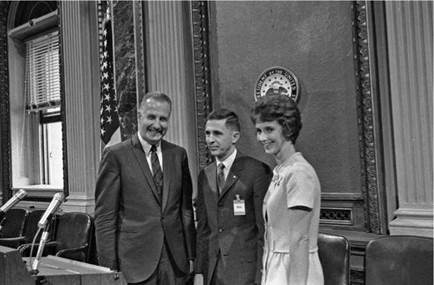Why Spiro Agnew?
Richard Nixon’s vice president, Spiro T. Agnew, was not an obvious choice to chair a review of the U. S. space program. Agnew had been elected governor of Maryland in 1966; before then he was a local Maryland politician. He had no prior exposure to space issues, or indeed to most national issues. Agnew had first supported Nelson Rockefeller as the Republican nominee for president in early 1968. But Rockefeller, much to Agnew’s surprise, in March 1968 had announced he would not enter presidential primaries or otherwise campaign for the Republican nomination. (He later reversed this position and competed with Nixon to be the Republican nominee.) Richard Nixon met with Agnew for the first time two weeks later; Nixon was “impressed with his intelligence and poise.” Nixon’s campaign asked Agnew to be one of Nixon’s nominators at the Republican convention; this put him among the leading candidates to be Nixon’s choice for the vice presidential nomination. After two of Nixon’s closest advisers turned down the vice presidential possibility, Nixon informed Agnew that he was his choice as vice-presidential candidate. Nixon noted in his Memoirs that Agnew at his first press conference admitted that his name was not exactly “a household word,” and assured the press “that he would work to change that situation.” In ways likely not intended, Agnew succeeded in that objective.39
There was a straightforward reason for involving Vice President Agnew in space affairs. The vice president by law was the chairman of the National Aeronautics and Space Council, the White House organization set up by the 1958 Space Act to provide presidential-level coordination of space policy. At its origin, the president chaired the Space Council, which included as members the administrator of NASA, the secretary of defense, the secretary of state, and the chairman of the Atomic Energy Commission. When John
F. Kennedy became president in 1961, he asked the Congress to change the law to make the vice president the council chair. Kennedy recognized that Vice President Lyndon B. Johnson had been deeply involved in space matters in the Senate, and he wanted to give Johnson some specific responsibilities during the Kennedy administration. Johnson in his role as Space Council chair had played an important part in developing the recommendations that led Kennedy to set a lunar landing within the decade as a national goal, but in the remaining 30 months of the Kennedy administration he had limited influence on space choices. Johnson did accumulate a sizeable staff for the Space Council. Once Johnson became president and chose Hubert Humphrey as vice president and thus council chair, the Space Council during the rest of the Johnson administration had become almost dormant, even while it retained its large staff.
The Nixon transition task force on space had discussed what to do with the Space Council. It observed that “the Space Council has not been very effective” and observed that President Nixon could ask Congress to abolish it. But, “as long as the Council exists. . . it should be made effective. For that purpose, there should be a strong staff and the President should be Chairman.” As he considered how best to organize the post-Apollo space review, science adviser DuBridge also considered what to do with the council. One option, suggested Russell Drew, the space specialist on DuBridge’s staff, was to “strengthen the Space Council,” with a “vigorous and knowledgeable person as Executive Secretary.” The Executive Secretary was the presidentially appointed, Senate-confirmed top staff person for the Space Council and ran the day-by-day operations of its staff. If the president were to replace the vice president as chair of the Space Council, then the council staff could logically become part of the presidential science adviser’s office and the executive secretary could report to the president through DuBridge. (It is likely that OST staffer Russell Drew aspired to the position.) The other alternative was to abolish the Space Council, but this would be likely to run into vice presidential opposition, since it would mean that he would lose a large number of dedicated staff positions.40
There was no serious consideration at the start of the Nixon administration given to making the president the Space Council chair. However, over the course of 1969, there were attempts to revitalize the Space Council. One step in that direction was the May 1969 selection of 34-year-old Apollo 8 astronaut Bill Anders as the Space Council’s new executive secretary. NASA Administrator Paine was instrumental in Anders’s selection, seeing an opportunity to place someone positively disposed toward human space flight in a senior White House position, counterbalancing the skepticism of OST and OMB. Anders could not take on the job immediately, since he was part of the Apollo H backup crew; this meant that the council staff would not become engaged in the work of the STG. Anders had become convinced that he was unlikely to get a role on a later Apollo flight that would give him the opportunity to walk on the Moon, and so was ready to take on a new and very different challenge with the Space Council position. He was told
|
Vice President Spiro T. Agnew introduces his choice as executive secretary of the National Aeronautics and Space Council, Apollo 8 astronaut Bill Anders. Anders is accompanied by his wife Valerie. (National Archives photo WHPO-1044-8) |
by Agnew and Paine that once he came to Washington he would have the opportunity to reinvigorate the Space Council and its staff so that they could play a more influential role in space policy development.41
But that was in the future; by coming into the vice presidency with the Space Council as one of his assigned responsibilities, Spiro Agnew in February 1969 became the titular leader of the effort to define the U. S. future in space. Few could have predicted at the time that he would become perhaps the program’s leading cheerleader within the Nixon administration.











